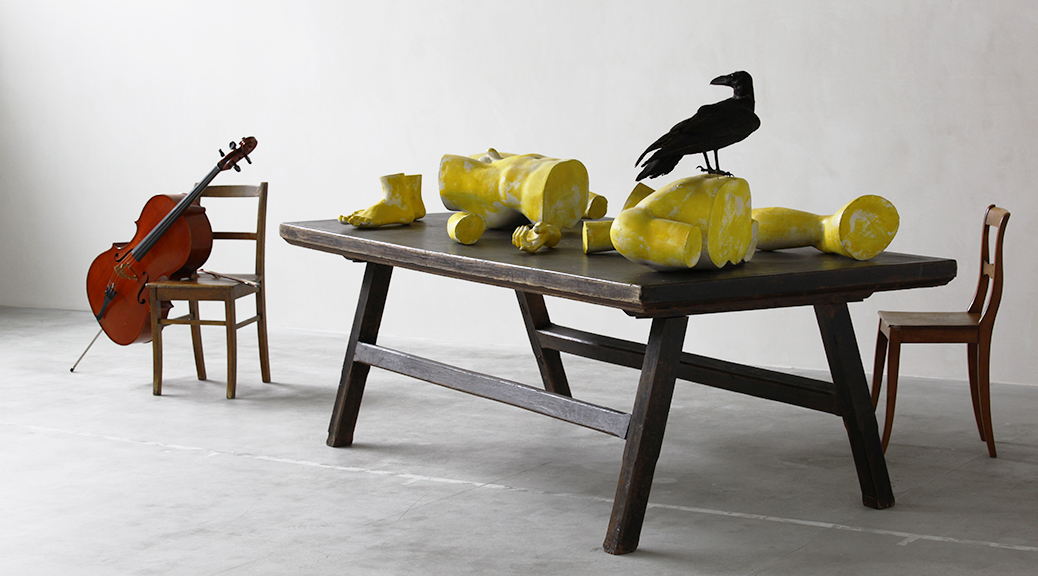Jannis Kounellis
Senza titolo, 1973
In 1973, during an era of protest against hypocritical values and reactionary systems, Kounellis placed a suggestive “still life” with fragments of a classical statue on display. Conceptual art was booming; many artists sought to liberate themselves from traditions by “escaping images” – in order to lead to a renewal of art and society.
Kounellis also sees himself as a rebel – but not as an iconoclast. Quite the contrary. As critical as he is poetic, he creates real, new images from fragments of cultural history. His appeal to society is not a break with the past; instead, he points to the deep truths buried in myths – without being conscious of them, collective progress isn’t conceivable. For him, perceiving history is a key to recognizing the present and shaping the future.
This untitled work, the so-called “Apollo”, is one of Kounellis’ main works – and beyond that, the embodyment of an idea of art that leads to insights. The “image” was originally tied to a performance: the artist sat behind the fragments of the Greek statue and held the mask of “Apollo’s” head in front of his face while a flutist played a Mozart melody. A short time later, Kounellis gave the work a different touch by coloring the plaster a sun-hued yellow and, under the influence of Brecht, having Weill played on a cello.
The artist appears here as a creator. He participates in shaping the world with his creative abilities. In front of him lies – metaphorically – a cultural heritage that must be revived. At his side is a visionary bird: an attribute of the God of light and prophecy, Apollo.Jannis Kounellis
Senza titolo, 1973
1973, in einer Epoche des Aufbegehrens gegen heuchlerische Werte und reaktionäre Systeme, stellt Kounellis ein suggestives „Stillleben“ mit Elementen der Antike in den Raum. Es ist die Blütezeit der Konzeptkunst, in der viele Künstler danach streben, sich durch einen „Ausstieg aus dem Bild“ von tradierten Vorstellungen zu befreien, um in Kunst und Gesellschaft eine Erneuerung herbeizuführen.
Auch Kounellis versteht sich als Rebell – nicht jedoch als Bilderstürmer. Im Gegenteil: Gleichermassen kritisch wie poetisch, schafft er aus Fragmenten der Kulturgeschichte reale neue Bilder. Sein Appell an die Gesellschaft ist nicht der Bruch mit der Vergangenheit, sondern der Hinweis auf die tiefen Wahrheiten der Mythen, ohne deren Bewusstsein kollektive Entwicklung nicht denkbar ist. In der Wahrnehmung der Geschichte liegt für ihn ein Schlüssel für das Erkennen der Gegenwart und die Gestaltung der Zukunft.
Das Werk ohne Titel, der sogenannte „Apollo“, ist ein Hauptwerk von Kounellis – und, darüber hinaus, einer Erkenntnis schaffenden Kunstauffassung. Ursprünglich war das „Bild“ mit einer Performance verbunden: Hinter den Bruchstücken der antiken Statue sass der Künstler und hielt sich die „Apollo“-Maske vor das Gesicht, während ein Flötist eine Mozart-Melodie spielte. Wenig später gab Kounellis dem Werk einen anderen Ton, färbte die Gipsstücke sonnengelb und liess, unter dem Einfluss von Brecht, auf dem Cello Weill erklingen.
Der Künstler tritt hier als Kreator in Erscheinung. Mit seiner schöpferischen Fähigkeit partizipiert er an der Gestaltung der Welt. Vor ihm liegt – metaphorisch – ein kulturelles Vermächtnis, das es neu zu beleben gilt. Ihm zur Seite steht, als Attribut des Sonnen- und Musengotts Apoll, der Vogel, der die Gabe des Sehers hat.
